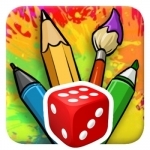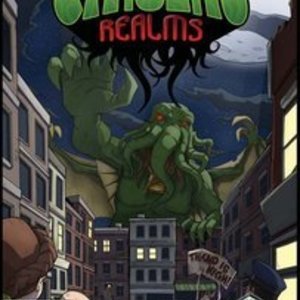
Pocketbooth Photo Booth
Photo & Video and Entertainment
App
Turn your iPhone, iPad, or iPod touch into a 1950s-era vintage photobooth with Pocketbooth: the...

Jazza's Arty Games
Art & Design, Entertainment and Games
App
Jazza's ARTY GAMES is a fun tool you can use to accompany your drawing sessions to practice with,...

CookPix, my own visual cookbook
Food & Drink and Utilities
App
Appetite comes with watching. CookPix lets your create your own digital recipe photo book on the...

Mountain Sniper Missions - 3D New Shooting Games
Games and Entertainment
App
You are just landed into killer enemy’s territory and you entered the furious shooting battlefield...
Purple Phoenix Games (2266 KP) rated Shadows of Kilforth: A Fantasy Quest Game in Tabletop Games
Sep 3, 2020
Shadows of Kilforth is subtitled, “A Fantasy Quest Game.” Right there in the title you find out exactly what you are up against in the very foreboding but unassumingly-sized box. A game set in a fantasy world that is focused on questing. I have to admit up front that this review will be treated a little differently as the rulebook is hefty and nobody wants to read a thorough rules essay on Shadows. So I will give you a very high-level overview of the main steps and then give you my thoughts on how it all works together.
DISCLAIMER: We were provided a copy of this game for the purposes of this review. This is a retail copy of the game, so what you see in these photos is exactly what would be received in your box. I do not intend to cover every single rule included in the rulebook, but will describe the overall game flow and major rule set so that our readers may get a sense of how the game plays. For more in depth rules, you may purchase a copy online or from your FLGS. -T
Shadows of Kilforth is essentially a card and dice RPG-esque adventure game with an Asian-style theme but set in a fantasy world where locations will be devastated into gloom (building upon the first in the series Gloom of Kilforth). The players, as the heroes, have the daunting task of journeying throughout Kilforth’s 25 locations to collect items, allies, spells, and titles to overcome main quests and subquests before every location falls into gloom. These quests usually have the players gathering specific card types to satisfy and complete. Once main player storyline quests, called Sagas, are completed the hero levels up and when they complete their fourth quest in their main Saga they may attempt their Finale and then may finally assault the big boss, the Ancient.
Each turn players have Action Points (AP) to spend on doing different actions: movement, discovering rumours (yes, I know it’s the Queen’s English), confrontations, and regaling a Saga chapter, among several others. Some actions are free actions, called Deeds. These include resolving loot tokens, assaulting an ancient, exchanging items between players, and several others. By using combinations of Actions and Deeds players will be able to travel around collecting those items, allies, and so forth needed to complete their Saga chapters.
To complete objectives and quests, players will typically be rolling dice to meet requirements on the cards. This, as all role-players know, can be either supremely lucky or incredibly and predictably debilitating. Skill checks are abundant in Shadows and diversifying characters may or may not have advantages by being able to complete Fight, Study, Sneak, and Influence tests. Players will win if they can complete their Sagas and defeat the Ancient before all of the locations fall into gloom, signaling the end of the game.
All this, again, is very high-level and there are many intricacies in Shadows that I just cannot go over for the sake of time and the health of my typing fingers. But, the game can be played solo, cooperatively, or competitively. So depending on the mode of play and number of players Shadows can range from a 45 minute foray to multi-hour epics. This is why I have played this solo with one character for my plays.
Components. Shadows of Kilforth is very card-heavy, but also includes other goodies. The cards themselves are firstly quite numerous, but also good quality. I can see myself sleeving this and loving every minute of that process. Aside from the cards, the game includes standees for player pieces on the card map, wooden components to track HP, AP, Fate, Obstacles, Gold, Hidden characters, great swirly 6d6, and also cardboard chits for Loot tokens. I haven’t even mentioned the art yet and that may be the most stunning component in this game! I LOVE a game with great art, and Shadows has simply amazing art. This is not usually my style of game art either, but it is so pleasing and everything makes sense and gets me immersed in the game. Everything provided is wonderful quality and an absolute joy to use during play.
Ok so like always, we place our ratings graphic right at the top of our posts so our readers can see right away what we think of the game. As you can tell, I love Shadows of Kilforth. It has essences of so many games I enjoy pieced together in a very attractive and captivating package. The movement and subsequent destruction of map-cards are reminiscent of Forbidden Island/Desert and Tiny Epic Defenders, which I really love (don’t hate – it’s a good game). The gathering of select card types and returning to a location to complete feels like fetch quests in MMORPGs (Final Fantasy XI being my main squeeze for many years). Obviously dice skill checks and level ups from tabletop RPGs are in there as well.
Shadows is just such a great collection of mechanics that I love that I can see myself playing this game over and over and over. Caveat: I will never play this any way other than absolutely solo. My first play, yes a learning session, was just shy of two hours from setup to tear-down. Adding players will increase game length, and playing with AP-prone friends is a no-go for me on Shadows; I had to reference both the excellent provided cheat sheet and the rulebook throughout the play but I eventually got the hang of it and was able to fly through. I may play this solo but with multiple characters cooperatively someday, but I do not wish to play this with other people. Ever.
So here’s my final thought. Shadow of Kilforth is a beefy game, but is well worth the time and effort to learn and play a couple times before passing judgment. It has everything I love in a game and I can’t stop thinking about it. I want to play all the different Race/Class combinations and just dunk on all the Ancients. If only my dice didn’t hate me so much. I will certainly be keeping this one forever, and if you are a fan of fantasy themed adventure card games with heavy use of dice and cool components, DEFINITELY take a look at Shadows of Kilforth. As I am the only one who has played this, I speak for the team in saying Purple Phoenix Games gives this one a 6 / 6. Treat yoself to this one, folks.
Purple Phoenix Games (2266 KP) rated Five Tribes in Tabletop Games
Jun 21, 2019 (Updated Dec 17, 2019)
DISCLAIMER: There are several expansions for this game. Though we have them in our collection, for this review we are only using the base game. Should we decide to review the expansions in the future we will add that information here or link to the full review. -T
Five Tribes is a game of area control, auction/bidding, card drafting, and set collection with a modular board. At the beginning of each round, players bid coins to determine turn order – the higher you bid, the earlier you get to go in the round. On your turn, you will select a tile, pick up all the meeples on it, and move them around the board – dropping only one on each subsequent tile, a la Mancala mechanic. There are strict rules regarding meeple movement and placement, so strategy is key in deciding the best path to VPs each turn. When you place your final meeple on a tile, take all meeples of that same color from the tile into your hand. If that completely clears the tile, place one of your camels on it to indicate that it is under your control. Each meeple color represents a different tribe, and each tribe grants the player certain powers when collected – i.e. gathering resources, gaining gold, or invoking Djinn powers. After you use your meeple power, you also have the opportunity to use the power of your ending tile, whether it is under your control or not. The game ends when a player has placed their final camel, or if there are no more legal moves to be made. VPs are tallied, and the player with the highest score wins!
As a kid, I played Mancala A LOT. I’m not entirely sure why. I learned it at school, caught the bug, and started playing it a ton at home too. Five Tribes takes Mancala and makes it 1000x better. The pick-up-and-drop mechanic is integral to the game, but there is so much strategy required that you will never be bored playing Five Tribes. You have to follow movement/placement rules, you have to figure out what meeple power you’d like to use on a given turn, you also have to decide if there’s a certain tile power you need – all while the board is constantly changing between each player’s turn. That’s why bidding for turn order can be so important! If you see a move that will earn you tons of VP, are you willing to spend your hard-earned gold (VP) to ensure that you can make that move? Or are you content with saving your gold and capitalizing on opportunities that may be presented later in the round? The board is constantly changing, and your strategy must follow suit if you are to have any hope of winning! There is no single strategy for a guaranteed win every game, and that keeps Five Tribes refreshingly fun and engaging.
The one negative I have about Five Tribes is that there is kind of a learning curve to this game. There are so many moving elements, different iconography, and special powers that it can be overwhelming for a new player. After a couple of plays, it is easier to remember the intricacies of the game, but at first it can be kind of daunting. Not a huge negative, just something to keep in mind when pulling it out for newer players!
Overall, I love Five Tribes. The gameplay is engaging, the strategic options are diverse and seemingly limitless, and the components are awesome quality. I only just got this game for Christmas last year, but it’s making its way up the ranks in my list of favorite games! If you haven’t already, give this game a try – there’s more to it than meets the eye! Purple Phoenix Games gives Five Tribes a fantastic 21 / 24.
Gareth von Kallenbach (980 KP) rated The Girl with the Dragon Tattoo (2011) in Movies
Aug 7, 2019
Daniel Craig stars as Mikael Blomkvist, who at the opening of the film has recently lost a court case for which he was being sued for libel by a prominent business figure. His career is in ruins and virtually all of his savings gone as a result of the trial and punitive damages. So when he is contacted by an attorney representing the wealthy and powerful Vanger family, he agrees to meet. Although highly reluctant to take a meeting, Mikael takes the four hour train ride north of Stockholm to a cold and remote island to meet with Henrik Vanger (Christopher Plummer). Henrik wishes Mikael to investigate the disappearance of his niece some 40 years earlier, a niece vanished under the families’ very noses and not a trace of her has been discovered since. Henrik is convinced that she has met with foul play, yet every year on his birthday, he continues to receive a gift of ornate pressed flowers in an anonymous package.
Henrik believes that the killer is haunting him by sending the gifts and that a member of his family may be to blame. Although skeptical of being able to find anything 40 years later, Mikael accepts the case and soon sets up residence in a small cabin on the island and begins his investigation by combing through police reports, conducting interviews, and examining photographs and newspaper clippings. Mikael had been warned that the other members of the Vanger family may not be too thrilled with his presence as not only is the family fractured, they all have their share of secrets.
At the same time, a very Goth punk girl named Lisabeth (Rooney Mara), is fighting her own demons. Lisabeth is an extremely gifted computer and surveillance expert who specializes in gathering background information on individuals. As such, her skills have made her in high demand with her employer. Unfortunately, Lisabeth is also a deeply antisocial person who is prone to lash out violently if provoked. Much of this stems from an extremely traumatic childhood spent in institutions which resulted in Lisabeth being placed as a ward of the state, not deemed competent to care for herself. This arrangement requires her to check in on a regular basis with a representative who, unfortunately for her, has recently suffered a stroke and places her in the care of the new guardian.
The new guardian subjects Lisabeth to horrific demands just so Lisabeth can access her money. The traumatized Lisabeth does not play victim long and in a twist of fate, is assigned by Henrik’s attorney to assist Mikael since she did the background check on him prior to Mikael being approached by Henrik for the investigation. The unlikely duo combined to form a highly efficient pair as they start to piece together the clues which indicate a brutal string of murders leading back for decades. As they work together, the relationship deepens and the reserved Lisabeth starts to come out of her shell. Tension mounts as danger surrounds them in an epic race against time to solve the case that certain members of the family do not want solved.
The film runs approximately 2 hours and 45 min and does take a little while to get started as the landscape and back story of the characters is established. The film has some very dark and brutal moments, which are hard to watch, yet were not as graphic as those in the Swedish language version. Craig and Mara work very well with one another and props to Craig for being willing to put on weight and occasionally looked disheveled to enhance his character.
Mara gives a masterful performance as the complicated Lisabeth, the anti-damsel-in-distress heroine, who subtly shows the many complicated sides to the character. Noomi Rapace first portrayed the character and has gone on to prominent success in Hollywood with a slew of upcoming high profile films. I would expect nothing less for Mara with two other sequels in this series to film. I am sure this breakout performance will not go unnoticed as it is an extremely difficult and daring role that few in Hollywood would want to tackle, much less be able to pull off as convincingly as she did.
I was extremely happy to see that the character names, settings, and situations were not changed in the new version, and it was refreshing to see the film set in Sweden and not relocated to London or New York. The biggest issue I had with the film was with the ending, which deviated from the previous versions. I will not provide spoilers, suffice it to say the resolution was a bit too tidy of a Hollywood ending and in my opinion greatly undermined one of the central characters of the film. That being said the film is a bold and dynamic vision from Fincher and is a deeply dark and disturbing story that is difficult to forget.

All In One Photo Studio Lab
Lifestyle and Photo & Video
App
All In One Photo Editor – The only photo studio tool that has it ALL and the only one you will...

Alien Slave Masters: Part Two
Book
When a distant planet’s ownership is in dispute, conquering aliens turn defiant human males into...
Dark Science Fiction Erotica MM
Purple Phoenix Games (2266 KP) rated Cthulhu Realms in Tabletop Games
Jun 12, 2019
In Cthulhu Realms, a deck-building game, you are a Cthulhu cultist that is trying to drive your rivals literally insane. By gathering followers, collecting artifacts, and discovering new locations, you will gain enough power to influence the sanity of those who would oppose you! On your turn, you will play cards from your hand to Conjure (acquire new cards from the communal pool), Draw/Discard cards, Gain/Lose Sanity, or Abjure (permanently discard cards from the game). The game ends when a player is reduced to zero sanity – and the player who has retained their sanity is the winner!
I love deck-building games. I really do. I think it’s a neat mechanic that allows you to customize your strategy with every play. So I enjoy playing Cthulhu Realms because of that element. And that’s kind of where my enjoyment ends with this game. Don’t get me wrong – it’s a decent game. I just have a couple of issues with the actual cards and abilities. The cards themselves are very reliant on iconography to communicate powers/abilities. Props to the player boards for having a quick reference for the basic actions, but I still always keep the rule sheet on hand for the in-depth explanation as I play. And even then, the rule sheet still has a bit of ambiguity on how some of the powers work. I wish they’d provided a couple of examples because sometimes I still get confused by certain combinations of icons. Just a little more detail in the rule sheet could alleviate some of the ambiguity of the icon abilities.
For card abilities, each individual card can have anywhere from 1-3 special abilities. The tricky thing is that the abilities do not all have to be used at the same time. So I could use 1 ability from a card, use an ability from a different card, and then come back to my first card and use another of it’s printed abilities. And with a hand of 5 cards every turn (not counting additional cards you may draw…), it can be hard to keep track of which abilities you’ve already used that turn. On top of that, many of the abilities have prerequisites – you can’t use that specific ability unless you’ve already played/have in play the requisite card. Some abilities only have 1 prerequisite, but some have 2, which just adds another layer of bookkeeping to your turns. Not only are you trying to remember which card abilities you’ve already used, but you’re also trying to keep track of your cards/actions that turn that could unlock other card abilities. The rule sheet suggests sliding a card to one side of your play area once you’ve used one of its powers. But again, if it has more than 1 ability on it, you’ve got to remember which ones you’ve used/haven’t used yet, regardless of where they are in your play area. This is a competitive game overall, but with all of these elements to track on your turns, it saps the tension from the game and makes it feel a little more luck-based than strategic.
To alleviate some of my grievances, I think the game could just have more cards with fewer abilities on each. That would make it much easier to execute all of your turns. And eliminate some of the ability prerequisites – having them on most of the abilities just adds another element for you to keep track of, and it feels a little unnecessary. If the turns were a little more clear and concise, I would like this game a lot more. It’s not bad, it just gets bogged down a little bit with too much action on your turns. That’s why Purple Phoenix Games gives Cthulhu Realms a 6/12.
https://purplephoenixgames.wordpress.com/2019/03/22/cthulhu-realms-review/



